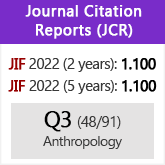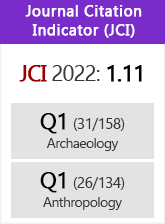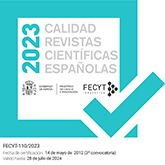Portable art in the Cantabrian Aurignacian. New contributions to provide a context of engraved bone of the Hornos de la Peña cave (San Felices de Buelna, Cantabria, Spain)
DOI:
https://doi.org/10.3989/tp.2008.v65.i1.138Keywords:
Portable art, Aurignacian, Engraved bone, Hornos de la Peña, Cantabrian, IberiaAbstract
In their excavations at the cave of Hornos de la Peña (Cantabria) at the beginning of the 20th century, H. Breuil, H. Obermaier and H. Alcalde del Río discovered the frontal bone of a horse engraved with a representation of that same animal. The excavators attributed the piece to the Aurignacian, but later studies have doubted whether it in fact belonged to that technocomplex. This doubt has arisen partly because until the stratigraphy at Hornos de la Peña has not been studied in detail and partly because the naturalistic character of the representation seemed to set it apart from the artistic conventions of the early Upper Palaeolithic of Cantabria. This article presents new information about the stratigraphy at the site obtained from a number of unpublished documents preserved in the archive of the Museo Arqueológico Nacional in Madrid, information that in our opinion supports an attribution of the piece to the Aurignacian.
Downloads
References
Alcalde Del Río, H. 1906: Las pinturas y grabados de las cavernas prehistóricas de la Provincia de Santander. Altamira, Covalanas, Hornos de la Peña y El Castillo. Blanchard y Arce. Santander.
Alcalde Del Río, H.; Breuil, H. y Sierra, L. 1911: Les cavernes de la région cantabrique: (Espagne). Impr. Vve. A. Chéne. Mónaco.
Alcolea, J.J. y Balbín, R. DE. 2007: “C14 et style: La chronologie de l’art pariétal a l’heure actuelle”. L’Anthropologie 111 (4): 435-466. doi:10.1016/j.anthro.2007.07.001
Arias, P. y Ontañón, R. 2004: “El contexto del arte mobiliar paleolítico en la región Cantábrica”. En P. Arias y R. Ontañón (eds.): La materia del lenguaje prehistórico. El arte mueble paleolítico de Cantabria en su contexto. Dirección General de Bellas Artes y Bienes Culturales. Santander: 37-52.
Barandiarán, I. 1972: Arte mueble del Paleolítico cantábrico. Departamentos de Prehistoria y Arqueología e Historia de la Antigüedad de la Universidad de Zaragoza. Zaragoza.
Bernaldo De Quirós, F. 1982: Los inicios del Paleolítico superior cantábrico. Ministerio de Cultura. Dirección General de Bellas Artes y Archivos. Madrid.
Bosinski, G. 2004: “El arte paleolítico en Europa Central en el contexto de los tipos de asentamiento y las formas de vida”. En P. Arias y R. Ontañón (eds.): La materia del lenguaje prehistórico. El arte mueble paleolítico de Cantabria en su contexto. Gobierno de Cantabria. Consejería de Cultura. Santander: 85-103.
Breuil, H. y Obermaier, H. 1912: “Les premiers travaux de l’Institut de Paléontologie Humaine”. L’Anthropologie XXIII: 1-27.
Clottes, J. 2001: La grotte Chauvet: l’art des origines. Ed. Seuil. París.
Corchón, S. 1986: El arte paleolítico cantábrico: contexto y análisis interno. Ministerio de Cultura, Dirección General de Bellas Artes y Archivos. Madrid.
González Sainz, C.; Cacho, R. y Fukazawa, T. 2003: Arte paleolítico en la Región cantábrica. Base de datos multimedia Photo VR, DVDROM versión Windows. Universidad de Cantabria, Consejería de Cultura, Turismo y Deporte de Cantabria. Santander.
Hahn, J. 1989: “Las primeras figuras: las representaciones auriñacienses”. En G. Albrecht; G. Bosinski; R. Feustel; J. Hahn; B. Klíma y H. Müller-Beck (eds.): Los comienzos del arte en Europa Central. Catálogo de la exposición celebrada en el Museo Arqueológico Nacional de Madrid. 1 de marzo-16 de abril de 1989. Dirección General de Bellas Artes y Archivos. Madrid: 27-35.
Klíma, B. 1990: “Chronologie de l’art mobilier Paléolithique en Europe centrale “. En J. Clottes (ed.): L’Art des objets au Paléolithique. Tome I. L’Art mobilier et son contexte. Direction de Patrimoine. Ministère de la Culture de France. Mas d’Azil: 133-141.
Leroi-Gourhan, A. 1971: Préhistoire de l’art occidental. D’Art Lucien Mazenod. París.
Malerba, G. y Giacobini, G. 2002: “Fiche éclats diaphysaires avec marques transversales d’utilisation”. En M. Patou-Mathis (ed.): Retouchoirs, compresseurs, percuteurs: os à impressions et éraillures, Industrie de l’os préhistorique, Cahier X. Société Préhistorique Française. París: 29-37.
Obermaier, H. 1925: El hombre fósil. Museo Nacional de Ciencias Naturales. Madrid.
Sanchidrián, J.L. 2000: Manual de arte prehistórico. Ariel. Barcelona.
Tejero, J.M. y Bernaldo De Quirós, F. (e. p.): “Evidencias de trabajo en materias duras animales en el Auriñaciense de transición (N. 18) de la Cueva del Castillo (Puente Viesgo. Cantabria)”. Veleia. Volumen en Homenaje a I. Barandiarán.
Tejero, J.M.; Morán, N.; Cabrera, V. y Bernaldo De Quirós, F. 2005: “Industria ósea y arte mueble de los niveles auriñacienses de la Cueva del Castillo (Puente Viesgo, Santander)”. Pyrenae 36 (1): 35-56.
Züchner, C. 2003: “La Cueva Chauvet y el problema del arte auriñaciense y gravetiense”. En P. Bueno y R. de Balbín (eds.): El arte prehistórico desde los inicios del siglo XXI: Primer Symposium Internacional de Arte Prehistórico de Ribadesella. Ribadesella: 41-51.
Downloads
Published
How to Cite
Issue
Section
License
Copyright (c) 2008 Consejo Superior de Investigaciones Científicas (CSIC)

This work is licensed under a Creative Commons Attribution 4.0 International License.
© CSIC. Manuscripts published in both the printed and online versions of this Journal are the property of Consejo Superior de Investigaciones Científicas, and quoting this source is a requirement for any partial or full reproduction.All contents of this electronic edition, except where otherwise noted, are distributed under a “Creative Commons Attribution 4.0 International” (CC BY 4.0) License. You may read here the basic information and the legal text of the license. The indication of the CC BY 4.0 License must be expressly stated in this way when necessary.
Self-archiving in repositories, personal webpages or similar, of any version other than the published by the Editor, is not allowed.

















